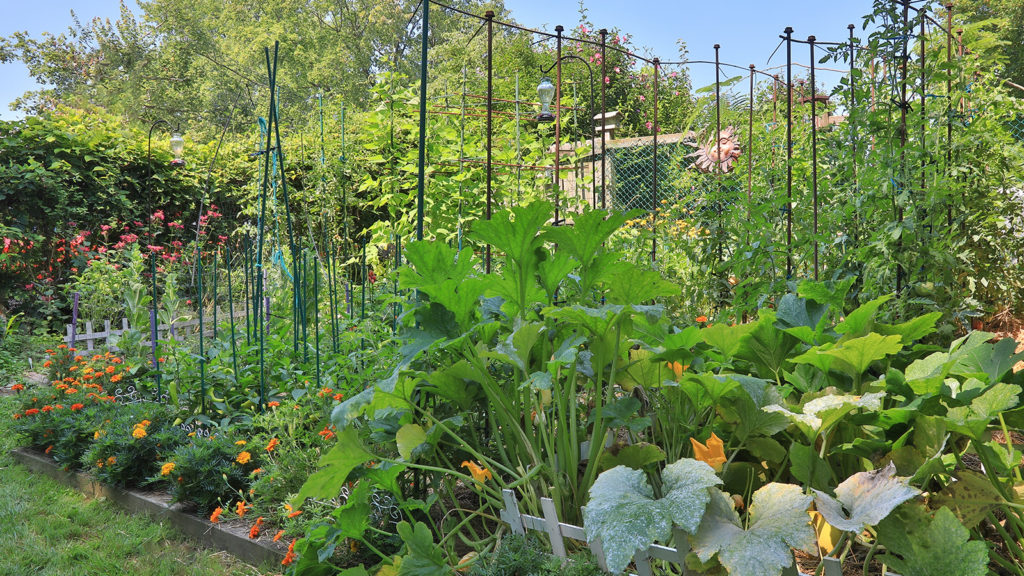A Pantser’s Paradise: Experimenting yields playful gardens
Mistress Mary, quite contrary,
How does your garden grow?
With silver bells, and cockle shells,
And marigolds all in a row.
By Amy Rognlie
I must confess that I have always imagined Mistress Mary’s garden as quite unappealing. Planting stiff, formal rows of marigolds is a far cry from my own loose garden “design,” if one could call it that. I love the experimenting, the anticipation, the imagining of what could be, and am not afraid to try something new. I purposely embark on discovery adventures at the local garden center, watch British gardening shows or drool over seed catalogs to fuel my imagination. In fact, I’ve come to the conclusion that I’m a pantser when it comes to gardening.
In the world of fiction writing, there are two types of novelists: the plotters and the pantsers. A plotter is just what it sounds like — one hatches an idea for a book then proceeds to sit down and plot and plan the whole book from “once upon a time” to “and they all lived happily ever after (or not).” A pantser, on the other hand, tends to fly by the seat of her pants, hence the clever name. We pantsers have a more organic writing process; often beginning a story with only the tiniest seed of an idea. Then, we imagine our way through the scenes as we write, often surprising ourselves with plot twists and never quite knowing exactly how things are going to turn out in the end. It’s more exciting that way, right?
Admittedly, the pantser approach does not work (at least not in my life) when I’m wearing my other hats of teacher, wife, mom, grammy, etc. Perhaps that is precisely why it is so fun to experiment and play in the garden. A garden has, as Anne of Green Gables would say, “great scope for imagination.” The enjoyment that comes from musing on which exact shade of purple-leafed plant would complement the fiery-colored zinnias or how tall the sunflowers might grow is a quiet kind of happiness. The quest of finding just the right plant for that part-shady spot by the back door is its own kind of entertainment, and the satisfaction of eating a carrot or a cucumber you have grown from seed is not matched by anything else on earth.
 One of my experiments this year is to grow vegetables in with my flowers. Of course, this is not a new idea, and I had practiced this to some extent in the past. I always grow marigolds with my tomatoes, for example, because the marigolds help keep the pests away from the tomato plants. And I’m aware of some of the basics of what we Americans call, boringly, “companion planting.” The French, who have grown veggies and ornamentals together for centuries, call this type of garden a “potager,” which sounds ever so much more romantic (Anne again).
One of my experiments this year is to grow vegetables in with my flowers. Of course, this is not a new idea, and I had practiced this to some extent in the past. I always grow marigolds with my tomatoes, for example, because the marigolds help keep the pests away from the tomato plants. And I’m aware of some of the basics of what we Americans call, boringly, “companion planting.” The French, who have grown veggies and ornamentals together for centuries, call this type of garden a “potager,” which sounds ever so much more romantic (Anne again).
One main reason for combining flowers and veggies is that the flowers attract more pollinators to the garden, thus increasing pollination of the vegetable plants. Also, it seems that insects love to host dinner parties in beds that are planted entirely with one type of vegetable.
However, if flowers are interspersed with the vegetables, the damage to the veggie plants is often mitigated by the insects’ “confusion” over the smorgasbord.
Though a traditional potager — pronounced “pow-tuh-jay” — is a formally designed kitchen garden, the basic idea can be modified for the average home garden. To that end, and typical of my adventuresome approach to gardening, I plunged in to try it without a whole lot of serious planning, unless daydreaming counts. Happily, I have been enchanted with the contrast of lovely, lacy carrot fronds against the stiff leaves, straw-like flowers and pastel colors of the globe amaranth.
Again, due to my pantser personality, this pleasing combination sort of evolved after I decided that it was time to plant the amaranth, no matter what the newly sprouted carrots were doing at that moment. And the display of frilly, lime-green lettuce leaves contrasting with the narrower, grey-blue foliage of the blue breadseed poppy was a lovely tableau in early spring — an unplanned but felicitous marriage.
Now the beans, with their green, heart-shaped leaves and long, purple beans are flourishing between the lavender butterfly pincushion flowers and the yet-to-bloom Pam’s Pink Turk’s Cap. Pea vines are wending their way up through the lower, bare branches of the climbing rose on the fence, and a few lettuce plants are still producing, braving the Texas “sprummer” to provide me with tender leaves for my salads.
However, the hottest days of the summer will soon be upon us. Peas and lettuce will be no more, but boisterously thriving among the poppies, salvias and marigolds, the tomatoes, beans, zucchini and cucumbers are coming into their own. And speaking of cucumbers, another one of my experiments this year is growing cucamelons. I started them from seed in February and well, I guess that’s a story for next time in this girl’s garden. See you then!
Tips for June & July
- Potted plants could use some afternoon shade during this time of year and will dry out quicker than usual in the extreme heat. Be diligent about watering, but don’t overwater. Most plants do not like to be soggy.
- “Deadheading” or clipping the spent flowers off of your blooming plants will keep more flowers coming.
- Watch out for leaf rollers and other caterpillars that love to eat leaves this time of year. Either let the little critters enjoy themselves, pick them off by hand, or control them by spraying with Monterey B.t. once a week or so. B.t. is made from a naturally occurring bacterium and will help control the caterpillars without killing other beneficial insects in your garden.
- To cut down on water usage, put an empty bucket or two under your eave or downspout when rain is in the forecast. Plants love the unchlorinated water and you won’t have to use your hose as much.




